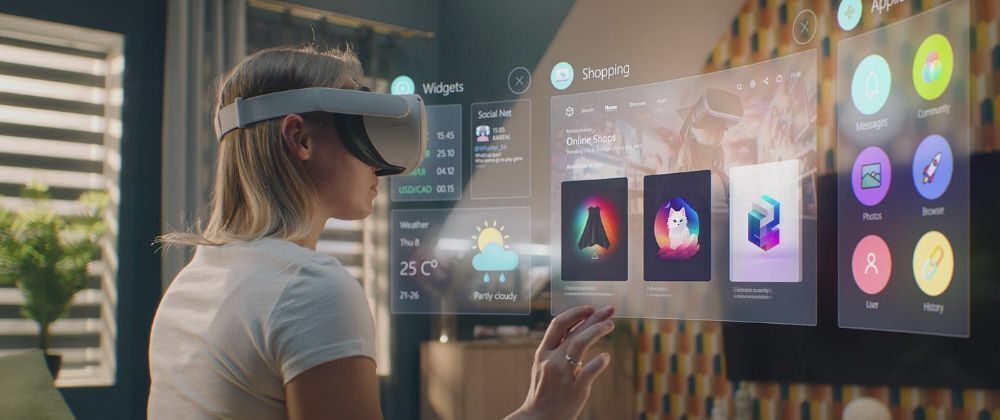The digital world is evolving rapidly, and with it, user expectations. In a landscape where seamlessness and engagement define user satisfaction, Augmented Reality (AR) and Virtual Reality (VR) have emerged as transformative forces in UI/UX design. These immersive technologies are not just enhancing visual appeal—they’re redefining how users interact with digital platforms.
Why AR/VR Matters in UI/UX Today
Gone are the days when flat, 2D interfaces dominated user screens. Modern users crave interactions that mimic real-life experiences. AR and VR provide that bridge between reality and virtual space—making interfaces more dynamic, intuitive, and engaging.
AR (Augmented Reality) overlays digital information in the real world—think Pokémon Go or AR furniture previews.
VR (Virtual Reality) immerses users in entirely digital environments, often via headsets, ideal for gaming, training, or simulations.
Together, AR and VR enhance UI/UX design services by creating personalized, intuitive experiences that help users connect with products and services more deeply.
The Shift From Passive Viewing to Active Experience
Traditional interfaces required users to adapt to technology. Now, technology adapts to users. In AR/VR experiences, the interface becomes a part of the environment, removing the friction that often comes with screens and buttons.
- Consider retail: Instead of browsing a product catalog, users can “try on” clothes via AR mirrors or walk through virtual showrooms using VR. These immersive designs increase engagement, reduce bounce rates, and elevate user satisfaction—hallmarks of exceptional UI/UX design service delivery.
Core Principles of UI/UX Design in AR/VR
Designing for AR and VR is not simply a matter of transferring existing UI patterns to a 3D space. It demands a rethinking of user interaction models. Here are some core principles guiding immersive design:
1. Spatial Awareness and Context
In AR/VR, users aren’t just clicking—they're moving, exploring, and reacting. Designers must consider depth, scale, distance, and perspective. Elements must appear naturally in the space and respond to real-world positioning.
2. Simplicity and Clarity
AR/VR environments can easily overwhelm users. A cluttered VR space or confusing AR overlay diminishes usability. Keep interactions clear, elements minimal, and movements intuitive.
3. Consistency and Feedback
Feedback is crucial in immersive UI. When users interact—via gaze, gesture, or movement—they need visual or audio confirmation to understand their actions. Haptic feedback (vibrations) is also becoming popular for VR devices.
4. Accessibility
AR/VR interfaces must be inclusive. That means voice navigation, subtitle options, and adjustable environments for users with different abilities or sensitivities.
Real-World Use Cases of AR/VR in UI/UX
Here’s how businesses across industries are leveraging AR/VR to enhance user experience:
Retail & E-Commerce
Virtual fitting rooms and product visualization tools let users see items in real-life settings before purchasing. This improves decision-making and reduces returns.
Healthcare
VR is used for immersive therapy and medical training simulations, while AR assists surgeons with real-time data during operations.
Education & Training
Interactive 3D classrooms and simulations make learning more engaging and effective. Companies use VR for employee onboarding, equipment training, and safety drills.
Real Estate
Buyers can take virtual walkthroughs of properties, inspecting every corner as if they were physically present.
Each of these use cases involves tailored UI/UX design service solutions to create environments that are both functional and emotionally resonant.
Challenges in Designing AR/VR Interfaces
While promising, immersive design is not without challenges:
1. Hardware Limitations
AR/VR interfaces depend heavily on the quality of devices. Lag, motion sickness, or low-resolution visuals can hinder the user experience.
2. Learning Curve
Not all users are tech-savvy. Designers must consider onboarding flows that help new users become comfortable with 3D interfaces.
3. High Development Costs
Creating immersive environments takes more time and resources than traditional interfaces. However, the ROI often justifies the investment—especially in user retention and brand loyalty.
Best Practices for UI/UX Designers Working with AR/VR
If you're integrating AR/VR into your digital products, consider these design best practices:
Prototype early and often: Use tools like Unity, Unreal Engine, or WebXR to create quick prototypes.
User-test in real environments: Context matters. Test your designs in the physical or virtual setting where users will actually interact with them.
Stay platform-aware: Design varies across AR glasses, smartphones, VR headsets, and browsers. Tailor experiences accordingly.
Embrace user feedback loops: Allow users to report discomfort, disorientation, or confusion, and iterate rapidly.
Partnering with an experienced UI/UX design service provider can accelerate this process, ensuring your immersive experience is both functional and delightful.
The Future of Immersive UI/UX
As AR glasses become more accessible and VR headsets lighter and more affordable, immersive design will transition from novelty to norm. Expect:
Blended Reality Interfaces: Where digital and physical experiences merge seamlessly.
Voice and Gesture UIs: Interfaces responding to natural human interaction.
Hyper-personalized environments: Dynamic adjustments based on user behavior and preferences.
In this future, businesses that invest in immersive UI/UX early will have a significant competitive advantage—not just in tech, but in user loyalty and brand affinity.
Final Thoughts: Embrace the Immersive Revolution
AR and VR are not just buzzwords—they are powerful tools reshaping how people interact with digital products. For businesses, leveraging these technologies is more than innovation—it’s evolution. As users expect more fluid, lifelike experiences, immersive UI/UX design becomes the key to standing out.
If you’re ready to explore the future of digital interaction, now is the time to invest in professional UI/UX design service solutions tailored for immersive technologies.



Top comments (0)